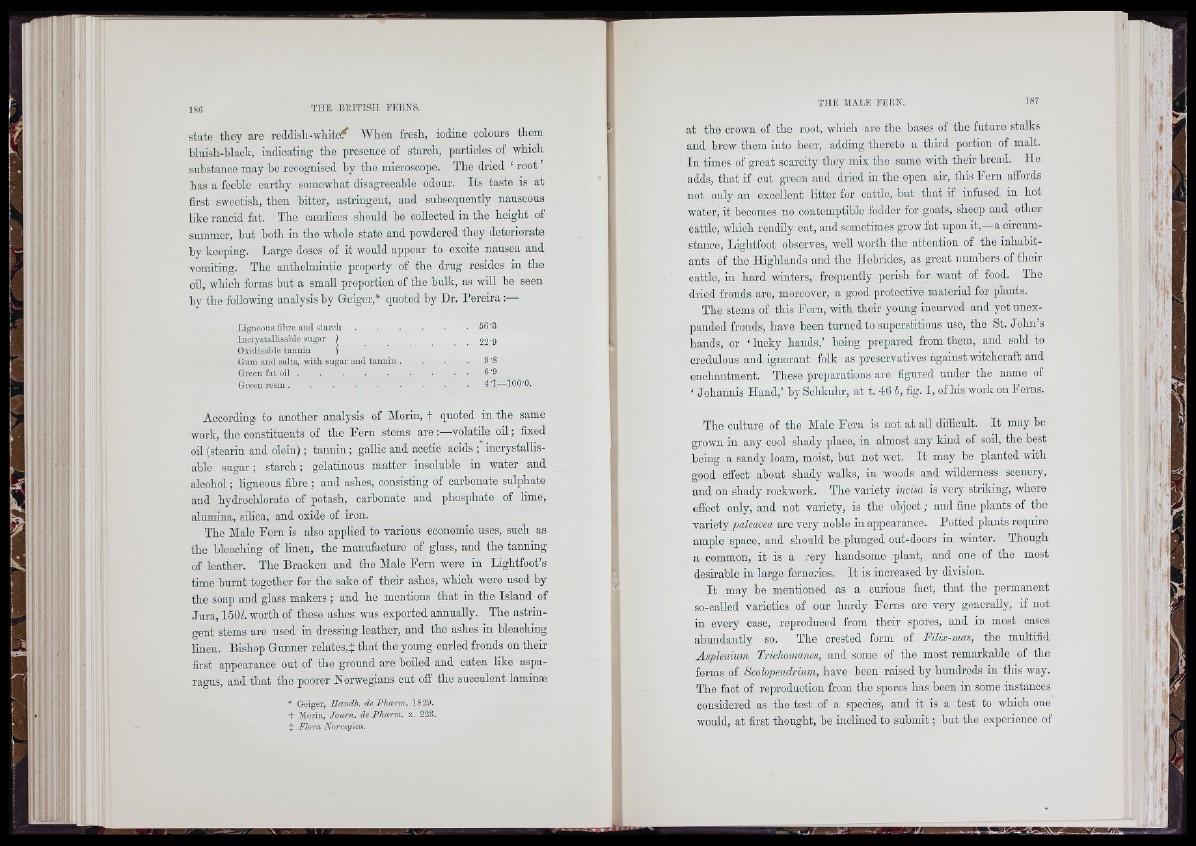
!!!
II
fl
Mi
180 THE BKITISH FERNS.
state they are reddish-whited When fresh, iodine colours them
hhiish-hlack, indicating the presence of starch, particles of which
suhstaiice may bo recognised by the microscope. The dried ‘ root ’
has a feohlo earthy somewhat disagreeable odour. Its taste is at
first sweetish, then hitter, astringent, and subsequently nauseous
like rancid fat. Tho oandicos should be collected in the height of
summer, but both in the whole state and powdered they deteriorate
hy keeping. Large doses of it would appear to excite nausea and
vomiting. The anthelmintic property of tho drug resides in the
oil, which forms but a small proportion of the hulk, as will he seen
hy the following analysis hy Geiger,* quoted by Dr. Pereira:—
Ligneous fil)rc and s t a r c l i .................................................... 56'3
Iiicrystallisable sugar ) 22-9
Oxidisable ta n n in )
Gum and salts, with sugar and tan n in . . . . 9 ’8
Green fat o i l ......................................................................... 6 ’9
Green r e s in ....................................................................................—lOO'O.
According to another analysis of Morin, f quoted in the same
work, the constituents of the Fern stems aro :—volatile o il; fixed
oil (stearin and olein); tan n in ; gallic and acetic acids ; incrystallis-
able su g a r; sta rch ; gelatinous matter insoluble in water and
alcohol; ligneous fibre ; and ashes, consisting of carbonate sulphate
and hydrochlorate of potash, carbonate and phosphate of lime,
alumina, sihca, and oxide of iron.
The Male Fern is also apphed to various economic uses, such as
the hleaohing of linen, the manufacture of glass, and the tanning
of leather. The Bracken and the Male Fern were in Lightfoot’s
time burnt together for the sake of their ashes, which were used by
the soap and glass makers; and he mentions th a t in the Island of
Jura, 150(. worth of these ashes was exported annually. The astringent
stems are used in dressing leather, and the ashes in bleaching
linen. Bishop Gunner relates,! that the young curled fronds on their
first appearance out of the ground are boiled and eaten like asparagus,
and that the poorer Norwegians cut off the succulent lamime
* Geiger, Handb. de Pliarm. 1829.
t Morin, Jo nm , de Pliarm. x. 223.
i F h r a Noreegica.
at tho crown of the root, which are the bases of tbe future stalks
and brew them into beer, adding thereto a third portion of malt.
In times of groat scarcity they mix the same with their broad. He
adds, that if cut green and dried in the open air, this Fern affords
not only an excellent litter for cattle, hut that if infused in hot
water, it becomes no oontomptiblc fodder for goats, sheep and other
cattle, which readily eat, and sometimes grow fat upon it,—a cironm-
stance, Lightfoot observes, well worth the attention of the inhabitants
of the Highlands and the Hebrides, as groat numbers of thoir
cattle, in hard winters, frequently perish for want of food. The
dried fronds aro, moreover, a good protective material for plants.
Tho stems of this Forn, with their young incurved and yet nnox-
panded fronds, have been turned to superstitious use, the St. John’s
hands, or ‘ lucky hands,’ hoing prepared from them, and sold to
credulous and ignorant folk as preservatives against witchcraft and
enchantment. These preparations aro figured under the name of
‘ Johaimis Hand,’ by Schkuhr, at t. 46 h, fig. 1, of his work on Ferns.
The culture of the Male Fern is not at all difficult. I t may he
grown in any cool shady place, in almost any kind of soil, the hest
being a sandy loam, moist, hut not wot. I t may bo planted with
good effect about shady walks, in woods and wilderness scenery,
and on shady rookwork. The variety incisa is very striking, where
effect only, and not variety, is the object; and fine plants of the
variety paleacea are very noble in appearance. Potted plants require
ample space, and should ho plunged out-doors in winter. Though
a common, it is a ,'ery handsome plant, and one of the most
desirable in large ferneries. I t is increased by division.
I t may be mentioned as a curious fact, th a t the permanent
so-called varieties of our hardy Forns are very generaUy, if not
in every case, reproduced from their spores, and in most oases
abundantly so. The crested form of Filix-mas, the multifid
Asplenium Trichomanes, and some of the most remarkable of the
forms of Scolopendrium, have been raised by hundreds in this way.
The fact of reproduction from the spores has been in some instances
considered as the test of a species, and it is a test to which one
would, at first thought, be inclined to submit; hut the experience of